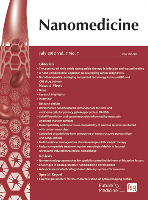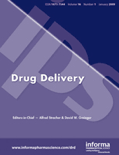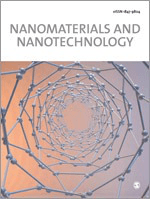
Artificial Cells Nanomedicine and Biotechnology
Scope & Guideline
Innovating Nanomedicine for Tomorrow's Therapeutic Breakthroughs.
Introduction
Aims and Scopes
- Nanoparticle Synthesis and Characterization:
The journal emphasizes the synthesis and characterization of various nanoparticles, particularly those derived from natural sources, highlighting their potential applications in drug delivery, antibacterial properties, and cancer treatment. - Biocompatibility and Therapeutic Applications:
Research on the biocompatibility of nanoparticles and their therapeutic applications is a core focus, with studies investigating how these materials can be effectively used in medical treatments. - Cancer Research and Treatment:
A significant portion of the journal's articles is dedicated to cancer research, exploring novel drug delivery systems, photodynamic therapy, and the role of nanoparticles in enhancing therapeutic efficacy. - Microbiome and Metabolomics:
The journal also addresses the interaction between nanoparticles and biological systems, including studies on the gut microbiome and its influence on health, as well as metabolomics-related research. - Innovative Drug Delivery Systems:
The development of advanced drug delivery systems, including liposomes, micelles, and other novel carriers for targeted and controlled release, is a prominent theme in the journal's publications. - Environmental and Green Chemistry:
Research on environmentally friendly synthesis methods for nanoparticles, emphasizing sustainability and reduced toxicity, is increasingly featured in the journal.
Trending and Emerging
- Artificial Cells and Biomimetic Systems:
Research on artificial cells and biomimetic systems is gaining momentum, highlighting innovative approaches to drug delivery and therapeutic interventions. - Nanotechnology in Regenerative Medicine:
The application of nanotechnology in regenerative medicine is emerging as a key theme, with studies exploring the use of nanoparticles for tissue engineering and regenerative therapies. - Machine Learning and Bioinformatics Applications:
There is an increasing trend towards integrating machine learning and bioinformatics in research, particularly in the analysis of complex biological data and the development of predictive models in medicine. - Therapeutic Nanoparticles for Infectious Diseases:
The journal is seeing a rise in publications focused on the use of nanoparticles for combating infectious diseases, particularly in the context of recent global health challenges. - Personalized Medicine Approaches:
Emerging studies are increasingly focusing on personalized medicine, utilizing nanoparticles and artificial cells to tailor treatments based on individual patient profiles.
Declining or Waning
- Traditional Chemical Synthesis Methods:
There is a noticeable decline in articles focusing on traditional chemical synthesis methods for nanoparticles, as the field increasingly shifts towards greener, more sustainable approaches. - Basic Mechanistic Studies without Application:
Research that centers solely on basic mechanistic studies without direct applications in nanomedicine or biotechnology is becoming less frequent, with a growing preference for studies that demonstrate practical therapeutic relevance. - In Vitro Studies without In Vivo Validation:
Papers that only present in vitro findings without subsequent in vivo validation are diminishing, as the journal increasingly prioritizes studies that bridge laboratory findings with clinical implications.
Similar Journals

Journal of Experimental Nanoscience
Advancing the Frontiers of NanoscienceThe Journal of Experimental Nanoscience, published by Taylor & Francis Ltd, is an esteemed open-access journal dedicated to advancing the field of nanoscience and its applications across various disciplines. Since its establishment, the journal has aimed to provide a comprehensive platform for researchers and professionals to disseminate innovative findings in nanotechnology, bioengineering, and materials science. With an ISSN of 1745-8080 and E-ISSN of 1745-8099, this journal has been pivotal in promoting high-quality research in its converged years from 2006 to 2024. Recognized for its contributions, it currently holds a Q3 ranking in core categories such as Bioengineering, Biomedical Engineering, Materials Science, and Nanoscience and Nanotechnology. Although its H-index is not specified, its Scopus ranks reflect its growing influence, with notable percentiles in various engineering fields. By offering open access since 2016, the Journal of Experimental Nanoscience enhances the accessibility of vital research to a global audience. Researchers, professionals, and students will find this journal an invaluable resource for staying abreast of the latest advancements and breakthroughs in nanoscience.

Nanomedicine
Advancing the Future of Medicine through NanotechnologyNanomedicine, published by Future Medicine Ltd, is a premier academic journal dedicated to the rapidly evolving field of nanotechnology in medicine. With an emphasis on innovative research and applications, this journal encompasses a broad spectrum of topics including bioengineering, biomedical engineering, and nanoscience, among others. Featuring an impressive Q1 ranking in Development and multiple Q2 rankings across significant categories, it serves as a pivotal resource for researchers and professionals aiming to stay at the forefront of advancements in these disciplines. While the journal is not open access, it is accessible through various institutional subscriptions, ensuring wide dissemination of cutting-edge findings. Notably, it has achieved substantial impact within the scientific community, indicated by its high rankings in Scopus and overall commitment to enhancing the understanding and application of nanomedicine. This journal is a vital conduit for fostering collaborations and innovations that transcend traditional medical paradigms.

BIOINORGANIC CHEMISTRY AND APPLICATIONS
Transforming research into real-world applications.BIOINORGANIC CHEMISTRY AND APPLICATIONS, published by HINDAWI LTD, is a distinguished journal dedicated to advancing the field of bioinorganic chemistry, offering an open access platform since 2008. With an ISSN of 1565-3633 and E-ISSN of 1687-479X, this journal provides a global forum for researchers, practitioners, and scholars in the vibrant fields of Biochemistry, Inorganic Chemistry, and Organic Chemistry. Recognized for its scholarly impact, it holds an impressive Q2 rank in Biochemistry and Q1 ranks in both Inorganic and Organic Chemistry in the 2023 metrics. Catering to a diverse audience, the journal emphasizes the importance of interdisciplinary research and the application of inorganic chemistry in biological systems. With an accessible range of articles aimed at fostering scientific dialogue and innovation, BIOINORGANIC CHEMISTRY AND APPLICATIONS plays a crucial role in shaping future research and application in the chemical sciences.

DRUG DELIVERY
Exploring Cutting-Edge Solutions in MedicineDRUG DELIVERY is a premier academic journal published by TAYLOR & FRANCIS LTD, with a steadfast commitment to advancing research in the fields of medicine and pharmaceutical sciences. As an Open Access journal since 2017, it offers unparalleled accessibility to its high-quality content, making it an invaluable resource for researchers, professionals, and students alike. With an impressive 2023 impact factor, it ranks in the Q1 quartile for both Medicine (miscellaneous) and Pharmaceutical Science, evidencing its significant impact within the scientific community. The journal focuses on innovative drug delivery systems, therapeutics, and methodologies that enhance patient care and treatment options. Based in the United Kingdom, it has evolved since its inception in 1993 to create a richly diverse platform for scholarly dialogue and advancements in the pharmaceutical landscape. Researchers looking to stay at the forefront of drug delivery research will find DRUG DELIVERY an essential companion in their pursuits.

Nanomaterials and Nanotechnology
Leading the Charge in Nanotechnology AdvancementsNanomaterials and Nanotechnology is a premier journal published by HINDAWI LTD, dedicated to advancing knowledge in the rapidly evolving fields of nanomaterials and nanoscale applications. Established as an Open Access platform since 2011, the journal aims to disseminate high-quality research that provides insights into nanotechnology's manifold aspects, including biotechnology, ceramics and composites, as well as electrical and electronic engineering. With a compelling impact factor reflected in its robust Scopus rankings—placing it in the 80th percentile in Engineering and the 72nd percentile in Biotechnology—it stands as a key resource for researchers, professionals, and students seeking to stay at the forefront of innovation in materials science. The journal occupies a distinguished position in the academic community, featuring studies that explore the synthesis, characterization, and application of nanomaterials, thereby contributing significantly to scientific discourse and technological advancement in this critical area.

ADVANCED DRUG DELIVERY REVIEWS
Driving Breakthroughs in Drug Delivery Mechanisms.ADVANCED DRUG DELIVERY REVIEWS, published by ELSEVIER, is a leading journal in the field of pharmaceutical sciences, particularly acclaimed for its contributions to the disciplines of pharmacology, toxicology, and pharmaceutics. With an impressive 2023 Scopus rank of #1 out of 183 in its category, this journal is situated in the Q1 quartile, reflecting its high impact and the relevance of its published research. Since its inception in 1987, it has continually focused on the latest advancements in drug delivery systems, making it an indispensable resource for researchers, professionals, and students interested in the innovative developments that shape the pharmaceutical landscape. The journal aims to publish comprehensive and authoritative reviews that foster a deeper understanding of drug delivery mechanisms, technologies, and their clinical applications. Although it operates under a subscription model, the value it provides through rigorous peer-reviewed content ensures it remains an essential tool for anyone seeking to enhance their knowledge in this rapidly evolving field.

Biomaterials Research
Innovating the future of biomedical engineering.Biomaterials Research, published by the American Association for the Advancement of Science, is a prominent open access journal established in 2014, dedicated to advancing the field of biomaterials. Based in the United Kingdom, this journal has swiftly become an essential platform for researchers and practitioners, offering groundbreaking insights in biomaterials, biomedical engineering, ceramics and composites, and miscellaneous medical fields. With its impressive Q1 ranking across multiple relevant categories in 2023 and its strong Scopus rankings, including a remarkable 90th percentile in the medicine category, Biomaterials Research showcases high-quality, peer-reviewed research designed to address both practical and theoretical challenges in biomaterials science. As an open access journal, it promotes wider dissemination and accessibility of research findings, crucial for fostering innovation and collaboration within the scientific community. Researchers, professionals, and students alike are encouraged to contribute, read, and engage with the latest developments in this dynamic field.

COLLOID AND POLYMER SCIENCE
Elevating Standards in Colloid and Surface ChemistryCOLLOID AND POLYMER SCIENCE is a prestigious peer-reviewed journal published by SPRINGER that serves as a vital resource for researchers, professionals, and students in the fields of Colloid and Surface Chemistry, Materials Chemistry, and Physical and Theoretical Chemistry. With ISSN 0303-402X and E-ISSN 1435-1536, the journal has established itself as a significant contributor to the scientific community since its inception in 1974, continuously providing valuable insights into the dynamic interplay between colloids and polymers. The journal is recognized for its rigorous quality, reflected in its Quartile rankings; it stands in Q3 for Colloid and Surface Chemistry and Physical and Theoretical Chemistry, and Q2 for Materials Chemistry and Polymers and Plastics in 2023. COLLOID AND POLYMER SCIENCE is an important platform for disseminating high-impact research that addresses fundamental and applied aspects of these critical fields, enhancing our understanding of material interactions and fostering innovations. The journal operates under traditional subscription models, ensuring that optimal academic rigor is maintained. With a strong emphasis on interdisciplinary studies, it encourages contributions that bridge gaps between theory and application, making it an essential reading for those aspiring to excel in the diverse world of materials science.

MOLECULES
Innovative Research for a Global Scientific CommunityMOLECULES, published by MDPI, stands as a prominent open-access journal dedicated to the field of chemistry, with an exceptional reputation in various sub-disciplines. Since its inception in 1997, this journal has committed itself to the dissemination of innovative research, spanning topics in Analytical Chemistry, Organic Chemistry, Pharmaceutical Science, and Drug Discovery. With impressive rankings across Scopus categories—including a coveted Q1 designation in both Analytical Chemistry and Pharmaceutical Science—MOLECULES is recognized as a vital resource for researchers, professionals, and students aiming to stay at the forefront of scientific development. The journal’s data reflect its wide-ranging influence, holding high percentiles in multiple chemistry categories, thereby ensuring that its articles reach a significant audience. As an open-access journal, it provides unparalleled access to its content, available freely and globally, which promotes further advancement and collaboration within the scientific community. Its ongoing commitment to high-quality research from 1996 to 2024 reinforces its status as a leader in the academic publishing landscape.

JOURNAL OF NANOPARTICLE RESEARCH
Harnessing Nanotechnology for Interdisciplinary DiscoveriesJOURNAL OF NANOPARTICLE RESEARCH, published by SPRINGER, is a pivotal platform in the interdisciplinary field of nanotechnology, encompassing atomic and molecular physics, bioengineering, chemistry, condensed matter physics, and materials science. Operating since 1999 and converging through 2024, this journal presents cutting-edge research and innovations in nanoparticle science, aiming to bridge theoretical studies with practical applications. With a diverse scope that attracts articles ranked in various Q2 and Q3 category quartiles across its fields, including Bioengineering and Nanoscience and Nanotechnology, it ranks favorably within Scopus metrics, ensuring high visibility and impact among researchers. While the journal operates under traditional access models, it remains a critical resource for professionals and students alike, empowering them to advance their knowledge and drive future discoveries in this rapidly evolving area of study.